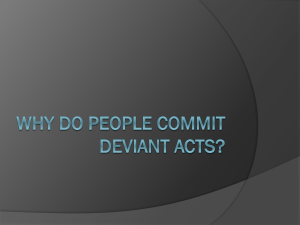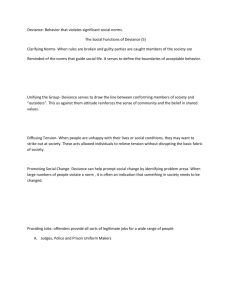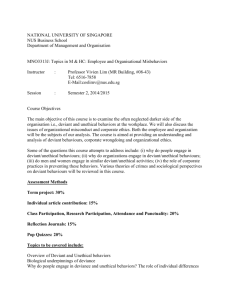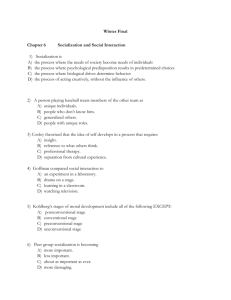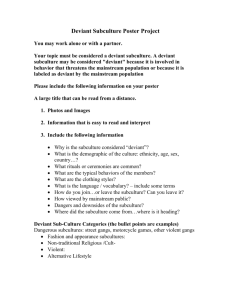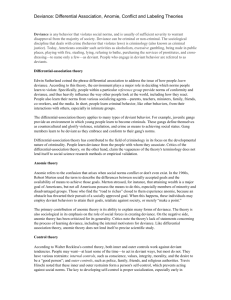Socialization of Individuals into Deviant Corporate Culture
advertisement
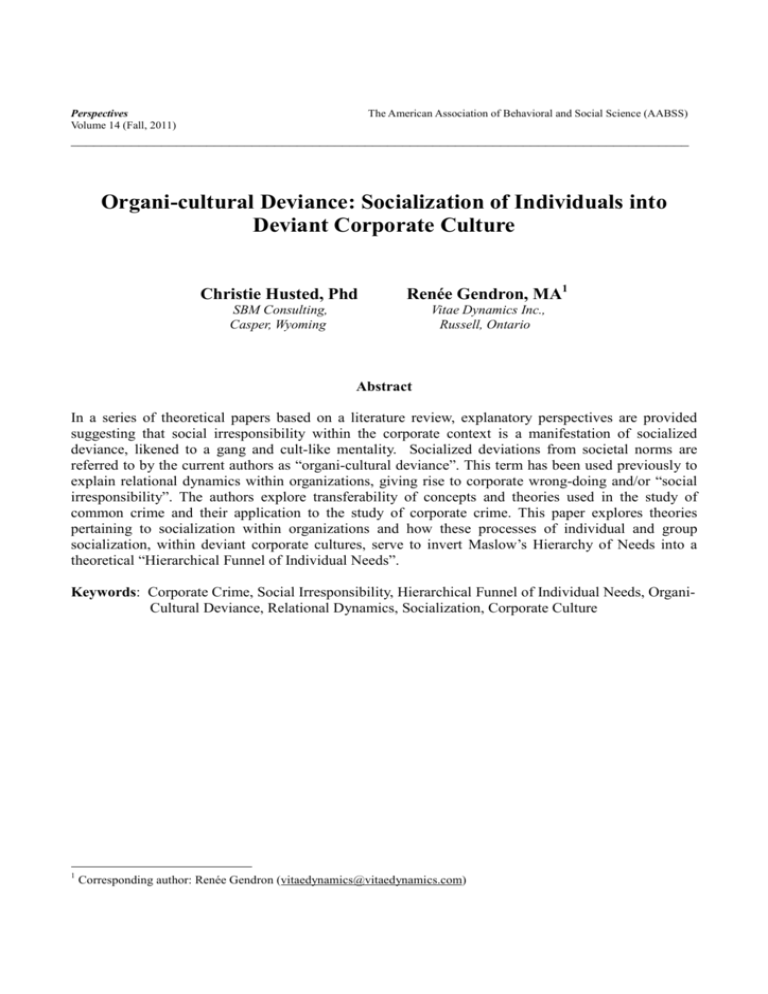
Perspectives Volume 14 (Fall, 2011) The American Association of Behavioral and Social Science (AABSS) __________________________________________________________________________________ Organi-cultural Deviance: Socialization of Individuals into Deviant Corporate Culture Christie Husted, Phd Renée Gendron, MA1 SBM Consulting, Casper, Wyoming Vitae Dynamics Inc., Russell, Ontario Abstract In a series of theoretical papers based on a literature review, explanatory perspectives are provided suggesting that social irresponsibility within the corporate context is a manifestation of socialized deviance, likened to a gang and cult-like mentality. Socialized deviations from societal norms are referred to by the current authors as “organi-cultural deviance”. This term has been used previously to explain relational dynamics within organizations, giving rise to corporate wrong-doing and/or “social irresponsibility”. The authors explore transferability of concepts and theories used in the study of common crime and their application to the study of corporate crime. This paper explores theories pertaining to socialization within organizations and how these processes of individual and group socialization, within deviant corporate cultures, serve to invert Maslow’s Hierarchy of Needs into a theoretical “Hierarchical Funnel of Individual Needs”. Keywords: Corporate Crime, Social Irresponsibility, Hierarchical Funnel of Individual Needs, OrganiCultural Deviance, Relational Dynamics, Socialization, Corporate Culture 1 Corresponding author: Renée Gendron (vitaedynamics@vitaedynamics.com) Perspectives Volume 14 (Fall, 2011) The American Association of Behavioral and Social Science (AABSS) __________________________________________________________________________________ Introduction This paper continues a series of explanatory and exploratory perspectives, using qualitative analysis, literature review and synthesis of generalized sociological, psychological and criminological theories, to describe the concept of organi-cultural deviance. This paper explores socialization within organizations and how actions, characteristics and patterns of behavior may be indicators of deviant corporate culture. The current authors propose an exploration of organizational processes with their impact on individual and deviant corporate group behavior providing insight into understanding the mechanisms behind the inversion of Maslow’s (1954) Hierarchy of Needs. In this paper, the authors refer to the process of inverting Maslow’s Hierarchy of Needs as the “Hierarchical Funnel of Individual Needs”. Organi-Cultural Deviance Defined Husted (2008) introduced the term “organi-cultural deviance” to explain the social, situational, and environmental factors that give rise to corporate deviance. Organi-cultural deviance was used by Husted to describe a corporate culture which has been socialized to engage in deviant acts. For the purposes of this paper deviant acts are defined as criminal acts under existing legislation. The authors expand the definition of “organi-cultural deviance” to include an individual or group behavior within a specific organization that may lead to wrong-doing or increase the likelihood of occurrence of wrongdoing. The term “corporate”, as used throughout this article, is defined as acts “done by or characteristic of individuals acting together; ‘a joint identity’; ‘the collective mind’; ‘the corporate good’" (Corporate, 2009). The term “corporate criminal” has been used to describe a myriad of deviant acts in the course of business. For the purposes of this paper, the terms “white collar crime”, “deviant corporate behavior,” and “corporate criminal” are used interchangeably. All three terms for this paper pertain to illegal acts engaged in by a company. Among the conclusions drawn from Gendron and Husted (2010) paper titled, Organi-cultural Deviance Part I: Socialized Deviance in Corporate America, was that imbalances in control, authority and power may increase the likelihood of corporate wrong-doing. Husted found that lack of Perspectives Volume 14 (Fall, 2011) The American Association of Behavioral and Social Science (AABSS) __________________________________________________________________________________ supervision, and/or an overabundance of supervision, sometimes referred to as “micro-managing” can have detrimental effects on an organization's culture. Furthermore, micro-management was found to coincide with the presence of “yes-men” (Conger, 1990). The term yes-men refers to lack of critical thought, input of substance from group members or meaningful opportunities to engage in constructive criticism of the leaders' actions, direction of the organization, processes and/or overall ethical soundness of a situation. Gendron and Husted (2010) believed the presence of too much supervision, and yes-men, increases “group think”. Group think occurs when there is a failure to incorporate criticism, new ideas, new information, or outside opinions into the decision making process (Chen, Lawson, & McIntosh, 1996, p. 582). There are eight symptoms of group think: i) illusion of invulnerability; ii) collective rationalization; iii) illusion of morality; iv) excessive stereotyping; v) pressure for conformity; vi) selfcensorship; vii) illusion of unanimity; and viii) mind guards: some members appoint themselves to protect the group from outside information, information which may cause damage to the group (Janis & Mann, 1977). Corporations engaging in organi-cultural deviance are believed to intentionally isolate themselves from normal, healthy interactions, processes, and actions. They develop their own deviant subculture with a strict system of rule enforcement. Moreover, the members of the deviant group are socialized by their deviant corporate subculture into unquestioning allegiance and are coerced into providing undivided time and attention to the group. The authors theorize that individuals entering such deviant corporate cultures are stripped of their personal identity and pursuit of self actualization. Individual identity is replaced with group identity and ultimate dependence upon the deviant corporation for the individual’s basic needs (food, shelter, safety). We also describe this process of loss of personal identity and resulting dependence on the group for basic needs as the “Hierarchical Funnel of Individual Needs”. Theories of Socialization The authors argue that deviant socialization intentionally invites and deliberately excludes some individuals for the express purposes of engaging in destructive behavior. The behavior may include the creation of destructive workplace conflict, bullying, otherwise unproductive and non-constructive behavior in the workplace, committing unethical acts, and/or crime. Perspectives Volume 14 (Fall, 2011) The American Association of Behavioral and Social Science (AABSS) __________________________________________________________________________________ Henle (2005) described Gough’s (1987) role-taking theory of sociopathy. Gough described a continuum with the asocial individual at one end, and the socialized individual at the other. According to Gough, asocial individuals are low in social maturity and morality. Asocial individuals tend to resist rules and regulations, are dissatisfied, and defensive. Van Maanen and Schein (1979) formulated a theory of socialization that depicts six dimensions of organizational variation. New organizational members can be subjected to experiences that are: i) collective or individual; ii) formal or informal; iii) sequential or random; iv) fixed or variable; v) serial or disjunctive; and vi) investitive or divestitive (Fogarty, 2000). ”Divestiture suggests that a recruit's inconsistent values perhaps acquired in previous socialization, need to be identified and replaced with other belie[fs]” (Fogarty). In addition to these six categories, Werner and DeSimone (2009) presented Schein’s three dimensions of organizational roles. The first aspect of an organizational role is the degree to which the organization is inclusionary. In other words, how likely is the new employee to be excluded from existing social groups within the organization. The second category is called “functional” and pertains to specific tasks required of the employee. The last category is “hierarchical” and pertains to the relative position in the overall official power structure of the organization (Werner & DeSimone, 2009, p. 251). An individual new to the organization must learn their role within the organization as well as the organization's specific culture. Miller (2009) referred to Stohl (1986), arguing that “socialization occurs through the communication of ‘memorable messages’ – narratives and cultural truisms that stick with employees as they continue in their employment” (Miller, 2009, p. 125). In relation to the method of group based socialization, Nyberg, Buckley, Harvey, Novicevic, and Wheeler (2007) argued “Employees who are socialized in groups will tend to have a very formal interpretation of their role in the organization and will adhere to this interpretation even when the environment changes” (p. 294). Social Learning Theory Social learning theory is largely based on behaviorism, in which positive and negative reinforcements shape and mold the behaviors of individuals. Individuals learn, acquire or cease to Perspectives Volume 14 (Fall, 2011) The American Association of Behavioral and Social Science (AABSS) __________________________________________________________________________________ engage in specific behaviors depending on the specific nature of the rewards and sanctions given by their social and physical environments (Encyclopedia of Psychology, 2001). Through interactions with other individuals, certain patterns of cognition and behavior are reinforced or sanctioned. The more people consider a specific behavior desirable, the more likely people are to engage in that behavior (p. 638). The current authors suggest in both deviant and non-deviant organizations the individuals who are inadequately socialized are weeded out of the organizations. This “weeding” process occurs when the individual becomes dissatisfied and resigns for another job opportunity. The individual’s low motivation and poor work performance can also result in termination by the employer. The probationary period of employment (when effectively instituted) should determine the fit between the individual and the organization. Functionalism and Merton Another institutional aspect related to organi-cultural deviance was argued by Robert Merton (1938) in his discussion of Strain Theory. Merton argued that some deviant behavior occurred when an individual accepted society's goals (becoming wealthy, owning specific possessions) but the individual did not have the means to legitimately obtain society's accepted goals. In order to achieve desired goals, the individual may turn to deviant behavior in order to obtain them (Ruggerio, 2005, p. 36). Coleman (1987) believed white-collar criminals justify and neutralize their behavior in regards to the concept of generalized others. However, Coleman turned his attention to political economy and industrial capitalism (p. 414). According to Coleman, interactionists realized the importance of financial self-interest as motivation for the white-collar criminal to engage in illegal acts. Coleman claimed this realization necessitated the analysis of a possible link between structural and socialpsychological variables (p. 416). In his discussion on culture of competition, Coleman (1987) suggested wealth and success are central goals of the human endeavour. He believed success was a badge of intrinsic worth. Competition for personal wealth and power is considered positive in capitalist society and is viewed as a builder of character. Coleman believed that a capitalist society views those most capable and hardworking as the most powerful and prosperous. This belief fuels inequality by its implication that those who are poor deserve their inferior position in society due to laziness (p. 416). Perspectives Volume 14 (Fall, 2011) The American Association of Behavioral and Social Science (AABSS) __________________________________________________________________________________ Unable to lawfully obtain goals that are deemed appropriate or correct by the specific organization or society writ-large, an individual or a group of individuals may engage in neutralization strategies and begin to engage in deviant behaviors. Often more acts of deviance are required to continue to meet the organization's or society's goals. In this process, the individual or group may negate any concerns about their actions arguing that it is in fact “market forces at work”, that there are “no real victims” in such transactions. Strong pressure to conform to the organizational desire and societal pressure for profit, results in some of the members of the organization engaging in deviant acts and processes to maintain the illusion that the legitimate goal was being pursued. This leads individuals and organizations into a false perception referred to as “illusion of control”. In 1975, Ellen Langer described illusion of control as a cognitive bias giving the individual the unrealistic perception that they have the skill or power to control situations that are in fact a matter of happenstance. The individual begins to engage in cognitive bias and self-deception, believing that they have the ability to change their luck. The current authors assume there are some circumstances in which the lawful pursuit of a goal is not possible. That is, instead of resigning to the fact that the goal is unattainable through legitimate means, the individual or group of individuals decide(s) to take risks and engage(s) in illegitimate behaviors under the pressure to conform or perform to organizational and societal expectations. When the individual is unable to meet organizational and/or societal expectations, the individual begins to take risks and gambles believing they have the power to change future negative outcomes to their favor. When the odds of an unfavorable outcome become more evident, the individual’s cognitive bias forbids them from surrendering and forces the individual to continue to engage in acts in a desperate attempt to rectify the situation and to tip the odds back into their favor. The inevitable result is a snowball effect, with increased odds stacked against the individual in rectifying the situation. Individual Indoctrination into Deviant Corporate Culture Corporations are social environments and sub-cultures of larger society. This gives rise to the current authors’ premise: individuals progress through stages of socialization into a deviant sub-culture. In 1992, Wanous identified stages of socialization in the workplace. Korte (2007) summarized Wanous’ stages as follows: 1) confront the reality of the new job –newcomers adjust their expectations to the Perspectives Volume 14 (Fall, 2011) The American Association of Behavioral and Social Science (AABSS) __________________________________________________________________________________ reality of the job; 2) achieve role clarity-newcomers learn and negotiate the expectations and requirements of their roles in the organization; 3) locate oneself in the organization-newcomers learn how their work contributes to the work of the organization; 4) assess success-newcomers assess the value of their contributions to the organization; and 5) during the stages of socialization, the individual learns the language of the organization. These are the symbolic constructs of the organization’s culture. Symbolic constructs are encompassed in sociological theory known as symbolic interactionism or what is referred to as Interactionist Theory. Husted suggested interactionist theory, strain theory and the culture of competition are interrelated and are relative to the understanding of organi-cultural deviance. According to Coleman (1987), interactionists evaluate “behavior in terms of the actor’s symbolic construction of the response anticipated from others, the expectation of significant others and the generalized expectations of society as a whole are critical elements in individual motivation” (p. 410). Culture of competition and Strain Theory focuses on materialism and monetary gain as being of utmost importance in capitalist society. Materialism and monetary gain are symbolic constructs. Each theory suggests these constructs motivate individuals to behave in particular ways due to societal pressure Husted (2008, p. 25). Theorists such as Goffman (1961) have studied the concept of total institution in regards to social interactionism. Goffman in his 1961 work titled Ássylum found the individual’s “self” is transformed through the following processes: i) role disposition; ii) programming and identity trimming; iii) dispossession of property, name and identity; iv) imposition of degrading postures, stances and deference patterns; v) contaminative exposure; vi) disruption of usual relation of individual actor and his acts; and vii) restriction on self-determination, autonomy, and freedom of action. The current authors expand Wanous’ (1992) stages of socialization and transfer the concepts of socialization, described by Goffman (1961), into the context of corporate crime. That is, we propose that organi-cultural deviance is a process of individual socialization into a deviant sub-culture. Upon entering the organization, the individual attempts to learn the rules and behaviors specific to the organization-the organization’s symbolic constructs. Individuals are attempting to establish themselves and identify their role within the organization. The individual is hyper-vigilant in complying with rules and regulations. The individual realizes the importance of first impressions, giving a good impression and being a team player in order to establish their position within the Perspectives Volume 14 (Fall, 2011) The American Association of Behavioral and Social Science (AABSS) __________________________________________________________________________________ organization. During this stage, the individual is not aware of established norms, the corporate culture, or organizational structure. The new member is introduced to the realm of possibility within the organization that rule compliance and attainment of organizational and group expectation and goals brings. During the Probationary Stage (“Probationary Period”), individuals who have not met the expectations or complied with the organization’s rules, policies and procedures have been weeded out by this point. Indoctrination Stage into the Deviant Sub-Culture Having proven their “fit” within the organization, the individual is accepted as a new member of the organization. The organization begins to give the individual more responsibility and status. Generally, there is increased sense of loyalty, commitment, and job security between the organization and its new member during this time. We propose that deviant organizations socialize the individual to transact the deviant organization’s goals during the Probationary Stage. As the individual successfully completes the Probationary Stage and progresses through the Indoctrination Stage, the individual loses their individual identity and has established unquestioning allegiance to the organization. The individual’s initial altruistic intent is replaced with fulfilling the intent of the organization. Individual deviation or questioning of the organization’s intentions is met with coercive means to regain individual compliance and unquestioning obedience. Individual loyalty to the organization is continuously tested. Tests require the individual to engage in less than ethical acts. Tests increase in level in regards to potential risk and consequence, as do the rewards. The individual is persuaded to engage in these unethical acts/tests by promises of substantial benefit/reward. The individual engages in the “Pleasure/Pain” process and finds the reward promised by the organization outweighs the risk of consequence. The risk of consequence is minimized by the organization through justification of the individual’s actions. Secret keeping becomes a reciprocal process and is used as blackmail leverage between the parties to maintain the cohesiveness of the transactional relationship. Perspectives Volume 14 (Fall, 2011) The American Association of Behavioral and Social Science (AABSS) __________________________________________________________________________________ The individual has entered into the organization at what Goffman (1961) calls the Role Dispossesion stage. During Role Dispossesion, the individual maintains many different and separate roles both inside and outside of the organization. When an individual becomes an employee in a new organization, they are seeking to add to their repertoire of roles. Ideally, their new role of employee and the title the position carries, should not interfere with the other roles the individual possesses outside the organization. This is not true in the deviant organization. The deviant corporate culture entices the individual to join the group with promises of utopia-like relationships and vast rewards. However, the individual’s personal identity begins to be stripped as the deviant organization begins to engage in the process Goffman referred to as Programming and Identity Trimming. Goffman’s (1961) Programming and Identity Trimming shares similarities with Lifton’s (1961) Thought Reform. Lifton identified eight characteristics of thought reform, which the current authors relate to socialization into the deviant corporate culture: i) Milieu Control- The individual becomes isolated from the outside world. The individual is discouraged from expressing dissenting views that are contradictory to the groups thoughts, beliefs or goals; ii) Mystical Manipulation-The group purports to have an altruistic purpose appealing to the individual’s desire to attain self-actualization through altruistic behavior; iii) Confession-The individual is encouraged to confide their anxieties, fears, past and current questionable behaviors to group members; iv) Sanctification-The group entices the individual to desire higher rewards. Transactional relationships are established. Reward is given when the individual transacts the group’s wishes; v) Aura of Sacred Science-The rules of the group are viewed as supreme governing rule. Dissenting views and non-compliance with these rules results in punishment; vi) Loaded Language-Symbols, acronyms, organization specific terms are used to convey meaning and messages. This language is reserved for members of the group and not accessible to the outside world; vii) Doctrine over Person-The group becomes the ultimate authority. The good of the group is the ultimate goal. Individuals are encouraged to sacrifice personal beliefs and values for the good of the group. Outside criticism, rules, norms are condemned by the group; and viii) Dispensed Existence-The individual’s dependence upon the group is engrained. Fear and threats are used to deter the individual from leaving the group. Like Lifton (1961), Goffman (1961) described Programming and Identity Trimming as exclusion of the individual from their self-identity. The current authors see the deviant organization as Perspectives Volume 14 (Fall, 2011) The American Association of Behavioral and Social Science (AABSS) __________________________________________________________________________________ isolating the individual from his/her outside world, increasing the individual’s needs on the organization to satisfy the individual’s needs of belongingness. Individual Needs Hierarchy and Organi-cultural Deviance Maslow’s Hierarchy of Needs Group membership serves to satisfy the individual’s need for belongingness, understanding, safety and physiological needs in Maslow’s (1954) Hierarchy of Needs. Abraham Maslow (1954) identified the following Hierarchy of Needs: 1) physiological; 2) safety; 3) love, affection, belongingness; 4) self-esteem; and 5) self-actualization (physiological being the most basic for survival and self-actualization being the need individuals strive for but few attain). It is proposed the lowest level needs must be met before the individual is able to advance to the next level. Organizations fulfil different levels of the individual’s Needs Hierarchy. Individuals are attracted to organizations who offer a means to satisfy the individual’s needs. Whether it be higher wages, more benefits, better working conditions, the individual’s motivation to enter the organization is their attempt to fill a real or perceived void in their personal hierarchy. Corporate cultures have the ability fill the social need of identity, the personal need of belonging to a group, as well as the financial need of earning a living. Human beings are social animals, desiring socialization, participation, and engagement in activities with other individuals. McCabe, Keibe Trevino and Butterfield (2001) argue that a group has internal controls regarding behavior. The group will try to regulate its behavior and develop its own norms (McCabe, Keibe Trevino, & Butterfield, 2001, p. 30). Henggler, Schoenwald, Borduin, Rowland, and Cunningham (1998) argued that deviant peers have a mutually reinforcing effect. As one peer is deviant, the other peers become increasingly deviant (pp.124-130). Wetherall (1996) referred to Tajfel and Turner's finding on individual self-identification. Tajfel and Turner found an individual’s motivation, judgements and perceptions are transformed when the individual becomes a member of a group. Taijel and Turner believed individual identity is transformed into social identity through the following processes: i) individual self-esteem becomes the result of the fortune of the group; ii) opinions of others outside the group become less relevant to the individual; and Perspectives Volume 14 (Fall, 2011) The American Association of Behavioral and Social Science (AABSS) __________________________________________________________________________________ iii) the individual adjusts their personal identity to match the thoughts, behaviors and other attributes of the group through a process called referent information influence (Wetherell, 1996, pp. 34-35). The authors suggest the individual’s quest to attain higher levels in their needs hierarchy are transformed into satisfying the needs of the organization. In essence, the authors propose deviant organizations invert the individual’s needs hierarchy from Maslow’s Hierarchical Pyramid into a “Hierarchical Funnel of Individual Needs”, though the process of organi-cultural deviance. The Hierarchical Funnel of Individual Needs Levels 5 & 4: Hierarchical Funnel of Needs-Facade of Honesty and Integrity Altruism and Accomplishment Needs. The current authors believe it is the “facade of honesty and integrity” which begins the inversion process of the individual’s needs hierarchy within the deviant organization. The authors suggest individuals are lured to the organization with promises of selfbetterment or improving their current situation (desire for self-esteem, accomplishment, selfactualization). Lifton (1961) refers to this process as Mystical Manipulation. Lifton described the process as an individual’s appeal to a group who purports to have altruistic purposes and intent. In the case of Enron, former CEO Jeffrey Skilling made a practice of hiring new employees on the basis that they would “think outside of the box” and they were “imaginative people”. Skilling also encouraged rewarded risk taking and distrusted traditional management styles (Tolson & Bernstein, 2002, lines 52, 54-55). In an interview on the Enron scandal, Kirk Hanson said 'The board is at fault for permitting the suspension of Enron's own code of conduct to permit the conflicts of interest inherent in the off-books corporations controlled by Fastow' (Nakayama, 2002, ¶ 9). The deviant organization begins to test the altruistic intent of the individual. The first test of individual altruism is to sacrifice personal beliefs and values for the good of the group. This requires the individual to engage in unquestioning obedience through a process Lifton referred to as Doctrine over Person. In testimony in the Enron trial, former Chief Financial Officer of Enron, Andrew Fastow, testified that Skilling was aware of illegal deals done to conceal losses and boost profits but did not want know the details of the transactions (Associated Press, 2006, ¶ 2). Perspectives Volume 14 (Fall, 2011) The American Association of Behavioral and Social Science (AABSS) __________________________________________________________________________________ Level 3: Hierarchical Funnel of Needs-Contempt for Others Friends and Family Needs. The deviant organization is believed to take advantage of the individual’s eagerness to learn by requiring “obedience and compliance” from the individual. The individual is isolated from outside/dissenting views from sub-cultures, as the deviant organization requires attention and devotion of time to the group (friendship, sense of belongingness needs). Lifton used the term Milieu Control to describe the process by which the individual becomes isolated from the outside world. In Milieu Control, the individual is discouraged from expressing dissenting views that are contradictory to the group’s thoughts, beliefs or goals. This use of symbolic constructs is what Lifton referred to as Loaded Language (symbols, acronyms, organization specific terms are used to convey meaning and messages). This language is reserved for members of the group and not accessible to the outside world and serves to further isolate and indoctrinate the individual into the deviant corporate culture. The group begins to transform the individual into a “yes person”, and discourages questioning and dissenting opinion through coercive power, and a process Lifton referred to as Aura of Sacred Science. In Aura of Sacred Science, the rules of the group are viewed as the supreme governing rule. Dissenting views and non-compliance with these rules results in punishment. In an interview concerning her book Willful Blindness, Margaret Heffernan said 'if the people at Enron had raised questions very much earlier, they might still have an employer' (Ridgeway, 2011, ¶ 19). The most high profile Enron whistle blower, former VP Sherron Watkins noted concerns about her safety and noted that “Fastow was "vindictive" and she feared for her personal safety as well as her family” (Pasha, 2006, ¶25). Level 2: Hierarchical Funnel of Needs-Group Think, Cognitive Dissonance, Manipulation Security and Employment Needs. The individual is discouraged from questionning authority, roles, and rules during the probationary period as he/she is acutely aware that she/he is expendable. The individual succumbs to “group think” under the threat of job loss. At first, the organization attempts to justify or neutralize the activities. Once the individual begins to accept the neutralization and justification, the individual begins to become enmeshed in observing or engaging in questionable Perspectives Volume 14 (Fall, 2011) The American Association of Behavioral and Social Science (AABSS) __________________________________________________________________________________ behaviors. The organization and its members use the individual’s knowledge or engagement in questionable activity against them. “Do as we say and we won’t tell on you and you will be rewarded” (security, resources). Confession - The individual is encouraged to confide their anxieties, fears, past and current questionable behaviors to group members. The deviant organization promises the individual great reward by transacting the group’s or organization’s wishes. This serves to re-establish the individual’s thought that they can improve the situation (illusion of control and desire for self-betterment). This is the organization’s “carrot and stick approach”. With Sanctification, the group entices the individual to desire higher rewards. Transactional relationships are established. Reward is given when the individual transacts the group’s wishes. They make huge promises, but fail to deliver. The huge reward is just outside the individual’s reach. As the individual becomes further entrenched in the deviant organization, the individual becomes increasingly dependent upon the organization to maintain their security. Security comes in the form of protection from prosecution and financial security. The individual begins to sacrifice their morals and ethics for financial security. Level 1: Hierarchical Funnel of Needs: Unwilling to Support Food and Shelter Needs. The individual realizes satisfaction of their basic needs relies on their continued employment in the deviant organization. As the degree or depth of organi-cultural deviance increases, the individual devolves down the inverted Maslow pyramid. As employees notice wrongdoing, unethical conduct or otherwise inappropriate conduct, the individual is increasingly put under scrutiny and is often the target of retaliation. This is likened to Lifton’s (1961) description of Dispensed Existence. The individual’s dependence upon the group is engrained. Fear and threats are used to deter the individual from leaving the group. Thus, the dependence of the individual for social survival, combined with real physical needs for survival (ability to earn money to purchase food and housing) leaves the individual vulnerable. Showing any signs of opposition and/or whistle blowing threatens their ability to meet their basic needs. A consequence of the individual’s devolution down the Hierarchical Funnel of Individual Needs is evident in Langan-Fox, Cooper and Klimoski’s (2007) comment “The severity of risk underlies why Rothschild and Miethe (1999) report that over half of US employees who observe conduct they Perspectives Volume 14 (Fall, 2011) The American Association of Behavioral and Social Science (AABSS) __________________________________________________________________________________ consider being unethical or illegal in the workplace remain silent”. Thus the deviant organization has claimed its victim, with the individual succumbing to organi-cultural deviance. Conclusion This paper reviewed the literature, synthesizing generally accepted psychological, sociological and criminological theory to explain and explore the concept of organi-cultural deviance. The current authors presented a theoretical perspective they coin the “Hierarchical Funnel of Individual Needs”, to describe the process by which an individual is recruited to a deviant organization by the Façade of Honesty and promises of self-betterment. As the individual is socialized into the deviant corporate culture, the individual is stripped of their personal identity, and becomes increasingly dependent upon the deviant organization to satisfy their most basic needs. Coercion, neutralization, justification, illusion of control, symbolic construct, loaded language, alienation/isolation, group think, and manipulation were discussed as factors in gaining compliance and garnering the individual’s unquestioning loyalty in transacting the groups goals and deviant acts. The authors propose these factors result in a cognitive bias, precipitating the individual to ignore or “blow the whistle” on deviant acts. It is believed the fear of reprisal, fear of social isolation, fear of personal safety, fear of losing their job and not being able to financially meet their their basic needs, results in the individual’s impotence in taking action against deviant acts. The individual has sacrificed their morals, ethics and value systems to satisfy their basic needs. The deviant organization has claimed its victim, by regressing the individual down the Hierarchical Funnel of Individual Needs. Perspectives Volume 14 (Fall, 2011) The American Association of Behavioral and Social Science (AABSS) __________________________________________________________________________________ References Associate Press. (2006). “Ex-Enron CFO said Skilling knew about fraud,” MSNBC Retrieved from http://www.msnbc.msn.com/id/11711094/40007981 (accessed May 1 2011). Chen, Z., Lawson, R., & McIntosh, B. (1996), Groupthink: Deciding with the leader and the Devil. Psychological Record, 46, 582. Coleman, J. (1987). Toward an integrated theory of white-collar crime. American Journal of Sociology, 93(2), 406-439. Conger, J. (1990). The dark side of leadership. Organizational Dynamics. 19(2), 44. Corporate. In The Free Online Dictionary by Farflex. The Free Online Dictionary: http://www.thefreedictionary.com/corporate (accessed May 15 2009) Encyclopedia of Psychology. “Social Learning Theory,” Encyclopedia of Psychology April 6 2001. Retrieved from http://findarticles.com/p/articles/mi_g2699/is_0003/ ai_2699000323/ Fogarty, T. J. (2000). Socialization and organizational outcomes in large public accounting firms. Journal of Managerial Issues. Retrieved November 30, 2010 http://findarticles.com/p/articles/mi_hb6703/is_1_12/ai_n28768865/ Gendron, R., & Husted, C. (May, 2010). Organi-cultural deviance. Paper presented at the Administrative Sciences Association of Canada, Regina, Saskatchewan, Canada. Goffman, E. (1961) Asylums: Essays on the social situation of mental patients and other inmates. New York: Doubleday Anchor. Gough, H. G. (1987). California Psychological Inventory: Administrator's guide. Palo Alto, CA: Consulting Psychologists Press. Henggler, S., Schoenwald, S., Borduin, C., Rowland, M., & Cunningham, P. (1988). Multisystemic treatment of antisocial behaviour in children and adolescents (124-130). New York, NY: The Guilford Press. Henle. C.A. (2005). Predicting workplace deviance from the interaction between organizational justice and personality. Journal of Managerial Issues. Retrieved December 3 2010, http://www.allbusiness.com/management/987516-1.html Husted, C. (2008). Systematic differentiation between dark and light leaders: Is a corporate criminal profile possible? Capella University. Perspectives Volume 14 (Fall, 2011) The American Association of Behavioral and Social Science (AABSS) __________________________________________________________________________________ Janis, I., & Mann, L. (1977). Decision making: A psychological analysis of conflict, choice, and commitment. New York: Free Press. Korte, R. (2007) Learning and socialization in the workplace. The college of business at the University of Texas. Tyler. Retrieved December 3 2010, http://www.uttyler.edu/cbt/hrd/documents/korte%20colloquium.pdf Langan-Fox J, Cooper C., & Klimoski, R. (2007). Research companion of the dysfunctional workplace. Chetlenham Gloucester, England: Elgar Publishing. Langer, E. (1975). The illusion of control. Journal of Personality and Social Psychology, 32, 311-328. Lifton, R.J. (1961). Thought reform and the psychology of totalism. A study of brainwashing in China. London: Gollancz. Maslow, A. (1954). Motivation and personality (2nd ed.). New York: Harper & Row. McCabe, D., Kiebe Trevino, L., & Butterfield, K. (2001), Dishonesty in academic environments: The influence of peer reporting requirements. Journal of Higher Education, 29-45. Merton, R. (1938). Social structure and anomie. American Sociological Review, 3, 672-82. Miller, K. (2009). Organizational communication: Approaches and processes (5th Edition). Boston, MA: Wadsworth Cengage Learning. Nakayama, A. (2002). Lessons from the Enron scandal. Markula Center for Applied Ethics. http://www.scu.edu/ethics/publications/ethicalperspectives/enronlessons.html (accessed May 1 2011). Nyberg, T.L., Buckley M.R., Harvey, M.G., Novicevic, M.M., & Wheeler, A., (2007). Socializing employees: Helping individuals develop appropriate expectations for both their work and the organization. In R.M. Sims (ed.), Human resource management contemporary issues: Challenges and opportunities. (287-302). United States: IAP-Information Age Publishing Inc. Pasha, S. (2006). Enron's whistle blower details sinking ship, CNN. Retrieved from http://money.cnn.com/2006/03/15/news/newsmakers/enron/index.htm Ridgeway, E. (2011). “Why it's easy to see no evil, speak no truth at work,” CNN Retreived from http://edition.cnn.com/2011/BUSINESS/03/01/business.blindness.heffernan/index.html Rothschild, L., & Miethe, T.D. (1999). Whistle-blower disclosures and management relaliation: The battle to control information about organizational corruption. Work and Occupaations, 26, 107128. Perspectives Volume 14 (Fall, 2011) The American Association of Behavioral and Social Science (AABSS) __________________________________________________________________________________ Ruggiero, V. (2010) Causation theories and concepts of organized criminal behavior. In F. Shanty and P. Paban Mishra (eds.), Organized crime: An international encyclopedia. Santa Barbara CA: ABC-CLIO Inc. Tajfel, H., & Turner, J. (1979). An investigative theory of intergroup conflict. In G.W. Austin and S. Worchel (eds.), The social psychology of intergroup relations. Monterey, CA: Brooks/Cole. Tolson, M., & Berstein, A. (2002). Skilling energized Enron but draws suspicion after its fall, Houston Chronicle. Retrieved from http://www.chron.com/disp/story.mpl/special/enron/1249343.html Van Maanen, J., & Schein, E. H. (1979). Toward a theory of organizational socialization. Research in Organizational Behavior, 1, 209-264. Wanous, J. P. (1992). Organizational entry: Recruitment, selection, orientation and socialization of newcomers (2nd ed.). Reading, MA: Addison-Wesley Publishing. Werner, J.M, & DeSimone, R.L. (2009). Human resource development (5th ed.). Mason, OH: SouthWest Cengage Learning. Wetherell, M. (1996). Identities group and social issues. London: Sage Publications.



